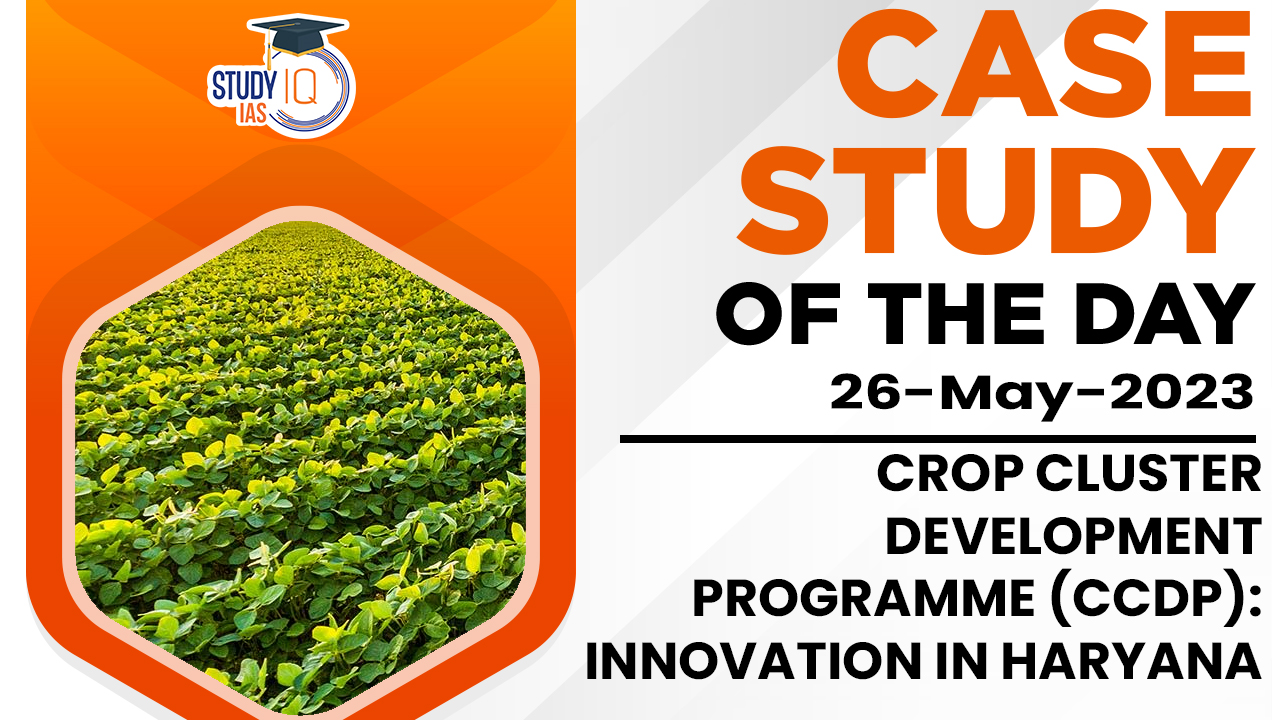Table of Contents
Crop Cluster Development Programme (CCDP) – Innovation in Haryana Background
- Haryana is predominantly an agrarian economy with agriculture serving as a significant source of employment and income for its rural population.
- Recognizing the need to boost agricultural productivity, promote sustainable farming practices, and improve rural livelihoods, the Haryana government launched the Crop Cluster Development Programme (CCDP).
- Cluster Development Programme (CCDP) is an innovative initiative aimed at enhancing agricultural productivity, sustainability, and rural livelihoods through the formation of crop clusters and the adoption of advanced farming practices.
Objectives of CCDP
- Facilitate the formation of crop clusters comprising farmers engaged in the cultivation of similar crops.
- Promote the adoption of innovative farming techniques, technologies, and best practices.
- Enhance market linkages and access to agri-infrastructure for improved value chain integration.
- Strengthen rural livelihoods and income generation opportunities through agricultural diversification and value addition.
Implementation Strategy
- Identification and formation of crop clusters: The programme identifies potential crop clusters based on factors such as geographical proximity, crop specialization, and farmer interest. Farmers engaged in the cultivation of similar crops are encouraged to form cohesive groups or clusters.
- Capacity building and training: The farmers in the crop clusters receive training and capacity building programs on various aspects of advanced farming practices, including crop selection, seed treatment, irrigation techniques, integrated pest management, soil health management, and post-harvest management.
- Technology adoption: The programme promotes the adoption of modern technologies such as precision agriculture, mechanization, drip irrigation, greenhouse farming, and organic farming practices. It provides technical assistance and subsidies to farmers to encourage the adoption of these technologies.
- Market linkages and infrastructure development: The CCDP facilitates improved market linkages for farmers by establishing farmer-producer organizations, agri-marketing infrastructure, and cold storage facilities. It also encourages the formation of value-added enterprises and supports farmers in accessing government schemes and subsidies.
- Monitoring and evaluation: The programme includes a robust monitoring and evaluation framework to assess the progress, identify bottlenecks, and make necessary adjustments for effective implementation.
Outcomes and Impact
- Increased agricultural productivity: The adoption of advanced farming practices has resulted in increased crop yields and enhanced productivity for farmers in the crop clusters. Improved access to quality seeds, efficient irrigation, and mechanization have contributed to this positive outcome.
- Sustainable farming practices: The programme has promoted the adoption of sustainable farming practices, including organic farming, integrated pest management, and efficient water management techniques. This has led to reduced chemical usage, minimized environmental impact, and improved soil health.
- Income generation and livelihood improvement: The CCDP has helped in diversifying rural livelihoods and generating additional income streams for farmers. Value addition through processing, branding, and marketing of agricultural produce has created employment opportunities and improved the economic conditions of rural communities.
- Market integration and competitiveness: By establishing better market linkages, the CCDP has enabled farmers to access larger markets, obtain fair prices for their produce, and reduce dependency on intermediaries. The establishment of agri-infrastructure facilities has improved the value chain integration and enhanced the competitiveness of farmers.
- Replicability and scalability: The success of the CCDP in Haryana has attracted attention from other states in India. The programme’s model has the potential to be replicated and scaled up to benefit farmers across the country.
Conclusion
- The Crop Cluster Development Programme in Haryana has emerged as an innovative initiative that combines technological advancements, sustainable farming practices, and market integration to boost agricultural productivity and improve rural livelihoods.
- By promoting crop clusters and encouraging the adoption of advanced farming techniques, the programme has created a conducive environment for agricultural innovation and development.


 SSC CGL Exam 2025 Apply Online Starts Ap...
SSC CGL Exam 2025 Apply Online Starts Ap...
 Daily Quiz 19 April 2025
Daily Quiz 19 April 2025
 Vehicle-to-Grid (V2G) Technology and its...
Vehicle-to-Grid (V2G) Technology and its...





















